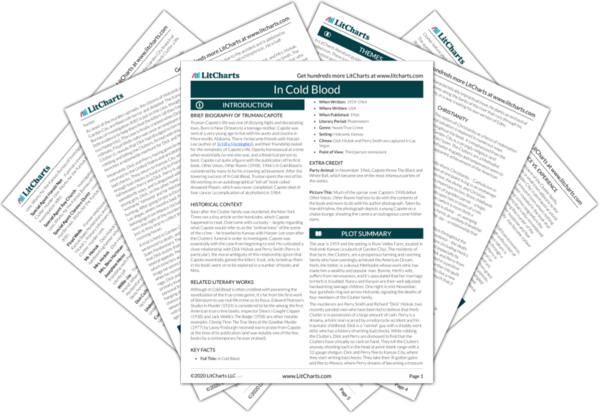Welcome to the LitCharts study guide on Truman Capote's In Cold Blood. Created by the original team behind SparkNotes, LitCharts are the world's best literature guides.
In Cold Blood: Introduction
A concise biography of Truman Capote plus historical and literary context for In Cold Blood.
In Cold Blood: Plot Summary
A quick-reference summary: In Cold Blood on a single page.
In Cold Blood: Detailed Summary & Analysis
In-depth summary and analysis of every chapter of In Cold Blood. Visual theme-tracking, too.
In Cold Blood: Themes
Explanations, analysis, and visualizations of In Cold Blood's themes.
In Cold Blood: Quotes
In Cold Blood's important quotes, sortable by theme, character, or chapter.
In Cold Blood: Characters
Description, analysis, and timelines for In Cold Blood's characters.
In Cold Blood: Symbols
Explanations of In Cold Blood's symbols, and tracking of where they appear.
In Cold Blood: Theme Wheel
An interactive data visualization of In Cold Blood's plot and themes.
Brief Biography of Truman Capote
Truman Capote’s life was one of dizzying highs and devastating lows. Born in New Orleans to a teenage mother, Capote was sent at a very young age to live with his aunts and cousins in Monroeville, Alabama. There, he became friends with Harper Lee (author of To Kill a Mockingbird), and their friendship lasted for the remainder of Capote’s life. Openly homosexual at a time when essentially no one else was, and a theatrical person to boot, Capote cut quite a figure with the publication of his first book, Other Voices, Other Rooms (1948). 1966’s In Cold Blood is considered by many to be his crowning achievement. After the towering success of In Cold Blood, Truman spent the rest of his life working on an autobiographical “tell-all” book called Answered Prayers, which was never completed. Capote died of liver cancer (a complication of alcoholism) in 1984.
Get the entire In Cold Blood LitChart as a printable PDF.

Historical Context of In Cold Blood
Soon after the Clutter family was murdered, the New York Times ran a tiny article on the homicides, which Capote happened to read. Overcome with curiosity – largely regarding what Capote would refer to as the “ordinariness” of the scene of the crime – he traveled to Kansas with Harper Lee soon after the Clutters’ funeral in order to investigate. Capote was essentially with the case from beginning to end. He cultivated a close relationship with Dick Hickok and Perry Smith (Perry in particular); the moral ambiguity of this relationship (given that Capote essentially gained the killers’ trust, only to betray them in his book) went on to be explored in a number of books and films.
Other Books Related to In Cold Blood
Although In Cold Blood is often credited with pioneering the novelization of the true crime genre, it’s far from the first work of literature to use real life crime as its focus. Edward Pearson’s Studies in Murder (1924) is considered to be the among the first American true crime books. Inspector Dew’s I Caught Crippen (1938) and Jack Webb’s The Badge (1958) are other notable examples. Closing Time: The True Story of the Goodbar Murder (1977) by Lacey Fosburgh received warm praise from Capote at the time of its publication (and was notably one of the few books by a contemporary he ever praised).
Key Facts about In Cold Blood
- Full Title: In Cold Blood
- When Written: 1959-1964
- Where Written: USA
- When Published: 1966
- Literary Period: Postmodern
- Genre: Novel/True Crime
- Setting: Holcomb, Kansas
- Climax: Dick Hickok and Perry Smith are captured in Las Vegas
- Point of View: Third person omniscient
Extra Credit for In Cold Blood
Party Animal: In November 1966, Capote threw The Black and White Ball, which became one of the most infamous parties of the sixties.
Picture This: Much of the uproar over Capote’s 1948 debut Other Voices, Other Rooms had less to do with the contents of the book and more to do with his author photograph. Taken by Harold Halma, the photograph depicts a young Capote on a chaise lounge, shooting the camera an outrageous come-hither stare.












